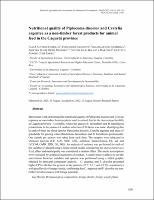Mostrar el registro sencillo del ítem
Nutritional quality of Piptocoma discolor and Cratylia argentea as a non-timber forest products for animal feed in the Caquetá province
| dc.contributor.author | Casanoves, Fernando | |
| dc.contributor.author | y otros cinco autores más | |
| dc.date.accessioned | 2014-10-18T02:48:06Z | |
| dc.date.available | 2014-10-18T02:48:06Z | |
| dc.date.issued | 2022 | es_ES |
| dc.identifier | 345249 | es_ES |
| dc.identifier.uri | https://repositorio.catie.ac.cr/handle/11554/3546 | |
| dc.description.abstract | The present work determined the nutritional quality of Piptocoma discolor and Cratylia argentea as non-timber forest products used in animal feed in the Amazonian foothills in Caquetá province - Colombia, where the grasses B. decumbens and B. humidicola predominate in the pastures.A random selection of 50 farms was made, identifying that in each of them the shrub species Piptocoma discolor, Cratylia argentea and areas of grasslands for grazing where Brachiarias decumbens and B. humidicola predominate. One sample per species was taken from each farm. The samples were subjected to chemical analysis (CP, ADF, NDF, ADL, cellulose, hemicellulose, EE, ash and IVDDM, OMD, TDN, DE, ME). An analysis of variance was performed for each of the variables evaluated using a linear mixed model, considering the species factor as a fixed effect and municipality was considered a random effect. The model assumptions were evaluated by graphical inspection of residual. A multivariate synthesis to see the interrelation between variables and species was performed using a biplot graphic obtained by principal component analysis. C. argentea and P. discolor presented higher CP levels than the grasses in the pastures (17.7; 13.1; and 6.15%, respectively) with good levels of energy intake, confirming that C. argentea and P. discolor are nontimber forest resources with forage potential. | es_ES |
| dc.format.extent | 12 páginas | |
| dc.language.iso | en | es_ES |
| dc.publisher | Firenze University Press | es_ES |
| dc.relation.ispartof | Journal of Agriculture and Environment for International Development | |
| dc.relation.uri | https://doi.org/10.36253/jaeid-13102 | |
| dc.rights | info:eu-repo/semantics/openAccess | es_ES |
| dc.subject | TECNOLOGIA DE ALIMENTOS | es_ES |
| dc.subject | FOOD TECHNOLOGY | es_ES |
| dc.subject | COMPOSICION DE LOS ALIMENTOS | es_ES |
| dc.subject | FOOD COMPOSITION | es_ES |
| dc.subject | PLANTAS DE RAMONEO | es_ES |
| dc.subject | BROWSE PLANTS | es_ES |
| dc.subject | PLANTAS LENOSAS | es_ES |
| dc.subject | WOODY PLANTS | |
| dc.subject | BROMATOLOGIA | |
| dc.subject | COMPOSICIÓN BROMATOLÓGICA | |
| dc.subject | BROMATOLOGICAL COMPOSITION | |
| dc.subject | ARBUSTOS FORRAJEROS | |
| dc.subject | FORAGE SHRUBS | |
| dc.subject | PLANTAS LEÑOSAS FORRAJERAS | |
| dc.subject | FORAGE WOODY PLANTS | |
| dc.subject.other | Sede Central | |
| dc.title | Nutritional quality of Piptocoma discolor and Cratylia argentea as a non-timber forest products for animal feed in the Caquetá province | es_ES |
| dc.type | Artículo | es_ES |
| dc.creator.id | https://orcid.org/0000-0001-8765-9382 | |
| dc.identifier.status | openAccess |


